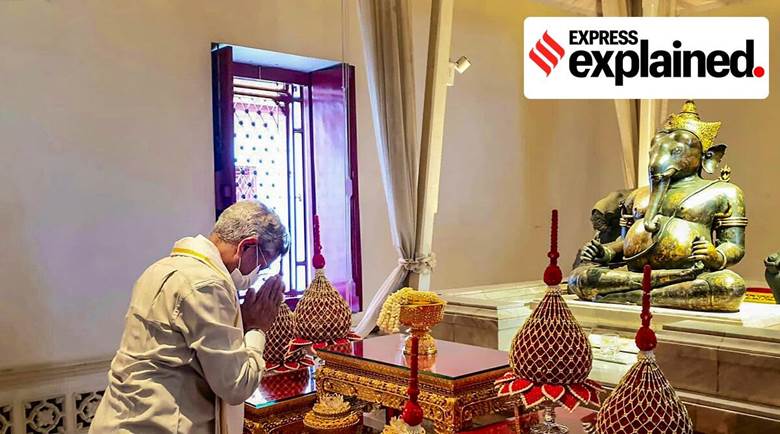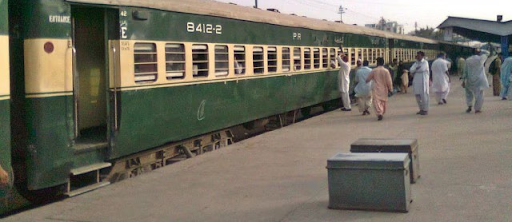Description

Copyright infringement is not intended
Context: As part of his visit to Thailand for the ninth India-Thailand joint commission meeting, External Affairs Minister S. Jaishankar visited the Devasthan in Bangkok. The Devasthan is the Royal Brahmin Office of the Thai Royal Court and is the official centre of Hinduism in Thailand.
Details:
- India and the Southeast Asia region share a long history of cultural and commercial relations.
- The classical Sanskrit and Pali texts from India carry references of the region using various names such as Kathakosha, Suvarnabhumi (the land of god) or Suvarnadvipa (the golden island), indicating that this was a region that attracted Indian merchants.
- Trade in spices, aromatic wood and most importantly gold is known to have flourished.
- In more recent times, European and Indian scholars have referred to Southeast Asia as ‘Farther India’, ‘Greater India’, or ‘Hinduised or Indianised states’.
- The first person to do an in depth study of the process of ‘Indianisation’ in Southeast Asian countries was a French scholar named George Coedes. He coined the term ‘Farther India’ to refer to those states that experienced “the civilising activity of India’. Geographically, it refers to Vietnam, Cambodia, Laos, Thailand, Myanmar and the Malay states.
- The Sanskrit, Buddhist, and Jain texts indicate that interactions between the two regions go back more than two thousand years ago, mainly through sea voyages and that trade played an important role.
- Contemporary Southeast Asian society carries several pieces of evidence of the cultural impact of these interactions.
- Many local languages in the region, including Thai, Malay, and Javanese contain words of Sanskrit, Pali and Dravidian origin in significant proportions.
- The Thai language is written in script derived from Southern Indian Pallava alphabet.
- Perhaps the most important influence of India on Southeast Asia was in the field of religion and how Shivaism, Vaishnavism, Theravada Buddhism, Mahayana Buddhism and later Sinhalese Buddhism came to be practised in the region. “The political and administrative institutions and ideas, especially the concept of divine authority and kingship
- The episodes of Ramayana and Mahabharata are regularly featured in puppet shows and theatre events. In terms of architecture, monuments like Borobodur Stupa in Java, the Angkor Vat temple in Cambodia, My Son temple in Vietnam are some of the best examples of Indian influence in the region.
India’s religious links to Thailand
- In the early centuries of the common era, Thailand, which was historically known as Siam, was under the rule of the Funan Empire.
- Following the decline of the Funan Empire in the sixth century CE, it was under the rule of the Buddhist kingdom of Dvaravati.
- In the 10th century, the region came under Khmer rule, which is also known to have links with India.
- A Tamil inscription found in Takua-pa testifies trade links between the Pallava region of South India and southern Thailand.
- A mercantile corporation of South Indians called Manikarramam had established a settlement here and built its own temple and tank, and lived as a ‘self-contained’ colony
- It is important to note that Brahmanism and Buddhism existed alongside each other in Thailand in the pre-Sukhothai period of the 13th century.
- The Mon kings of Dvaravati and the Khmers had patronised Buddhism and built several Buddhist edifices, but at the same time had also adopted Brahmanical customs and practises.
- The thriving coexistence of the two religions is evident from the fact that while Thailand today is a Buddhist majority country, there are many temples in the country where Buddhist and Brahmanical Gods are kept side by side.
- Apart from the popular Brahamanical deities of Ganesha, Brahma, Vishnu, and Shiva, those that are largely absent in Indian socio-religious landscape, such as Indra are also worshiped in Thailand.
- The Ramayana — known in Thailand as Ramakriti (the glory of Rama) or Ramakien (the account of Rama) — has provided an outlet of cultural expression in Thailand for both the elite and the common man

Background of relations:
- India and Thailand, located in each other’s extended neighborhood, share a maritime boundary in the Andaman Sea.
- India’s bilateral relations with Thailand are rooted in history, age-old social and cultural interactions and extensive people to people contacts.
- Thailand, which aspires to be a regional hub given its central location in South East Asia, initiated a 'Look West' policy in 1997. This seeks to accord priority to strengthening relations with South Asia and beyond.
- The 'Look West' policy of Thailand complements India's 'Look East' policy, which is now elevated to ‘Act East’ policy and has provided the basis for a substantive elevation of bilateral relations. Thailand also launched its ‘Act West’ policy in 2016.
- Thailand plays an important role in various regional and sub-regional groupings. It is, therefore, an important partner for India in the India-ASEAN Summit Level Partnership, the East Asia Summit (EAS), the Bay of Bengal Initiative for Multi-Sectoral Technical and Economic Cooperation (BIMSTEC), the Mekong Ganga Cooperation (MGC), Asia Cooperation Dialogue (ACD) Indian Ocean Rim Association (IORA) and Ayeyawady-Chao Phraya-Mekong Economic Cooperation Strategy (ACMECS).
- High level visits and meetings took place on a regular basis between both sides
- Bilateral Institutional Mechanisms
- Joint Commission Meeting
- Foreign Office Consultations
- Joint Task Force (JTF) on Maritime Cooperation
- Defence Cooperation:
- The MoU on Defence Cooperation between India and Thailand was signed on 25 January 2012.
- Since 2015, India is participating in Ex-Cobra Gold, the largest Asia Pacific Military exercise as ‘Observer Plus’ category.
- Bilateral exercises are held annually between the armed forces of both countries.
- Economic & Commercial Partnership
- Thailand views India as the gateway to South Asia and beyond.
- As a result of the reduced tariff rates and new initiatives adopted by both the countries, trade between two countries increased manifold in recent years.
- In 2020, despite the pandemic situation, the trade figures stood at US$ 9.76 billion. In 2021, it reached a record high of around US$ 15 billion.
- Cultural Cooperation
- An Indian Cultural Centre was opened in Bangkok in September 2009 [It has since been renamed as the Swami Vivekananda Cultural Centre].
- Cultural Exchange Programme for 2016-19 was signed during the visit of Thai PM to India in June 2016.
- A number of India Studies Centers are operational in prestigious Thai Universities.
- MoU on Cooperation in the field of Education was signed in 2005.
- The total number of people of Indian origin in Thailand is estimated to be around 175,000 and 20,000 NRIs, majority of whom are concentrated in Bangkok.
https://indianexpress.com/article/explained/historical-cultural-connections-between-india-and-thailand-explained-8098828/















